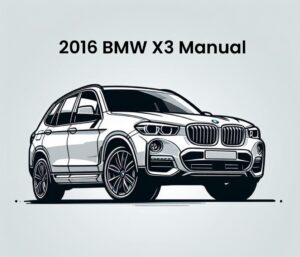The X3 comes in xDrive30i, xDrive30e and M40i models. With our manuals you can do regular maintenance, fix problems and repair to keep your X3 running smooth, whether it's a simple oil change or troubleshooting electrical problems. these BMW X3 factory repair manuals are simple and straightforward, task by task. Keep your X3 in top shape with guides to help you stay on top of repairs. Enjoy the peace of mind that comes with knowing more about your vehicle for a smoother and more enjoyable drive.
If you're not finding the right year for your exact car model or year, don't worry. We'll provide a repair manual tailored to your car.
Request A QuoteThe X3 was introduced in 2003 and set a new benchmark in the compact luxury segment. Designed with Magna Steyr, the first generation, E83, had BMW’s xDrive all-wheel-drive system and combined agility with practicality. In 2010, the second generation, F25, was launched in the US. This model had better performance, more refined design and more features like 8 speed automatic transmission.
By 2017, BMW launched the third generation, G01, which had the latest technology and efficiency improvements. This version was lighter and had more features like iDrive 6.0 and optional gesture control. G01 showed BMW’s focus on combining luxury with engineering.
In recent years, BMW added the all-electric iX3 to the X3 lineup, launched in 2020. This electric version retained the X3’s design and offered sustainable mobility with an 80 kWh , making it a strong player in the growing electric vehicle market.
Throughout its history, the BMW X3 has always evolved, with new technologies and design updates to stay ahead in the luxury crossover segment.
Which Models and Trims Does the BMW X3 Offer?
The BMW X3 lineup offers various models and trims, each catering to diverse driving needs. Here’s a breakdown of what you can find:
First Generation (E83, 2003-2010)
- xDrive25i/xDrive30i: Introduced with BMW’s all-wheel-drive system, these models emphasize sporty handling and comfort.
- xDrive20d/xDrive30d: Diesel variants focus on fuel efficiency without sacrificing performance.
Second Generation (F25, 2010-2017)
- xDrive28i/xDrive35i: These models offer turbocharged power with improved fuel economy and updated features.
- xDrive20d/xDrive30d: Diesel trims continue to provide robust torque and enhanced mileage.
- xDrive28d: Available in the U.S., this model introduces diesel efficiency to American drivers.
Third Generation (G01, 2017-present)
- xDrive30i: Balances performance with everyday practicality, featuring a turbocharged 2.0-liter .
- xDrive30e: A plug-in hybrid option offering electric efficiency alongside traditional power.
- M40i: A performance-focused model with a turbocharged 3.0-liter engine, delivers thrilling speed and agility.
- iX3: All-electric, this model combines classic X3 styling with sustainable energy solutions.
Each generation brings advancements in technology, design, and efficiency, ensuring the BMW X3 remains a top choice in luxury crossovers.
Why Are These Manuals a Must-Have for BMW Owners?
When it comes to maintenance and repair, BMW X3 workshop manuals are the ones to trust. Made for BMW X3 models only, these manuals are the most accurate and the go to for professional and DIY mechanics. With vehicle specific information these manuals help owners avoid costly mistakes and repair with confidence.
Workshop manuals cover everything unique to each model, so compatibility and quality in every repair. This saves time and effort and reduces future repair costs by allowing precise servicing.
- Reduces Repair Costs: Follow the maintenance instructions to the letter to avoid expensive repairs down the track.
- Model and year Specific: Unlike general guides, BMW’s workshop manuals have every model and year specific component so total compatibility.
- Tool & Part Numbers: The manual lists all the tools and parts required for each job so you can prepare.
- DIY Confidence: With factory accuracy you can do the job yourself without a mechanic.
What’s in a BMW X3 repair Manual?
BMW X3 factory manuals are the essential tools for servicing and repairing your vehicle. These manuals are full of model specific information to help X3 owners do the job right.
Every BMW X3 repair manual has sections like wiring diagrams, maintenance schedules and troubleshooting tips. Each section is specific to BMW X3 models and covers various systems and all repair and maintenance procedures.
BMW X3 Factory Manuals Covered
- Wiring Diagrams: Model specific diagrams to make electrical work easy, from minor adjustments to full system overhauls.
- Maintenance Schedules: Step by step guides for regular servicing, oil changes, tyre rotation and filter replacements to keep your X3 running at its best.
- Troubleshooting Tips: Advice on how to diagnose problems, from engine issues to electronic failures to save time and reduce repair costs.
- Parts and Component Diagrams: Visuals to help with complex repairs and assembly so DIY is easier and more accurate.
Here is detailed whats inside these Manuals
In addition to the main sections these manuals also cover:
- Replacing and Repairing Headlights and Signals
- Engine and Gear Maintenance
- Oil Changes
- Electrical Starters
- Electrical Inspection
- Tuning
- Common Mechanical Faults
- Tyre Alignment
- Turbo and Servicing
- Battery Servicing and Replacement
- HVAC Repair
- Exhaust Repair
- Systems
- Wiring Schematics
- General Vehicle Problems
- Steering System Inspection and Repair
- Interior and Exterior Care
- Brake Service
- diagnosis
- Replacement
- Transmission Fluid and Component Check
- Fuses and Relays Testing and Replacement
- Replacement
- Engine Performance diagnosis
- Sensor Calibration
- Alignment and Balancing
- Timing Belt and Chain Inspection
- Repair
- Fuel Consumption Check
- Servicing
BMW X3 Maintenance Schedules by Year
Following a maintenance schedule by your BMW X3’s model year is crucial to keep your vehicle running at its best. Each schedule breaks down the tasks into specific intervals so you can prevent wear and tear and maintain performance.
Model Year Maintenance Intervals
A table with maintenance intervals for each model year will help, with oil changes to full inspections.
- Oil and Fluid Changes: Oil and brake fluid changes every 10,000 miles or year.
- Brake and Suspension Checks: Check brakes and suspension components every 20,000 miles to prevent accidents.
- Engine and Transmission Inspections: Keep your X3’s engine and transmission running smoothly.
- Battery and Replacement: For cold weather and better fuel consumption.
Yearly Maintenance
Our guide is based on BMW’s official schedule and specific to each model year for exact maintenance.
- 2014–2016: Brake checks every 20,000 miles and coolant changes every 50,000 miles.
- 2017–2020: More frequent transmission fluid changes for newer engine designs.
- 2021–2024: Advanced diagnostics; newer models need proactive sensor checks and electric component servicing.
DIY for BMW X3 Repairs and Maintenance
Taking care of your X3 at home is easy if you have the right tools and follow some basic safety rules. Here are some DIY tips for safe and easy maintenance.
Tools for BMW X3 DIY Repairs
A good toolset is the first step to DIY work. Having the right tools will make repairs smoother and prevent damage.
- Socket and Wrench Set: For most repair jobs, bolts and nuts of all sizes.
- Torque Wrench: To ensure bolts are tightened to the correct specification, to prevent over-tightening.
- OBD-II Scanner: To read diagnostic trouble codes and diagnose problems.
- Jack Stands and Hydraulic Jack: For safe access under the vehicle during maintenance.
DIY Safety Tips for BMW X3 Repairs
DIY is safe if you follow the rules. Keep your workspace tidy and secure to avoid accidents.
- Work on a Flat Surface: Especially when using jacks or working under the car.
- Wear Protective Gear: Gloves, safety glasses and suitable clothing to prevent injuries.
- Disconnect the Battery: For electrical work to prevent electrical shocks.
- Check Your Owner’s Manual: To confirm repairs are in line with BMW’s guidelines.
DIY Common Mistakes to Avoid
DIY mistakes can cost time and money. Be prepared to avoid these.
- Double-Check Parts and Tools: Check replacement parts and tools are correct.
- Follow Step-by-Step Guides: Use the manual’s instructions to not miss any steps.
- Take Breaks to Avoid Fatigue: Working tired can lead to mistakes and risks.
- Know When to Ask for Help: Some repairs require expertise; if unsure, consult a professional.
Frequently Asked Questions













